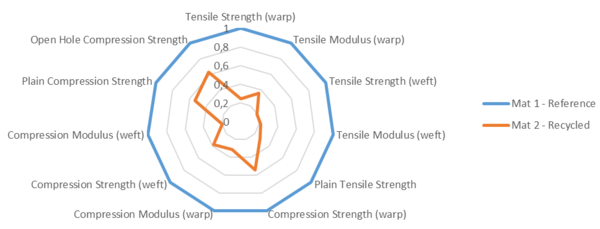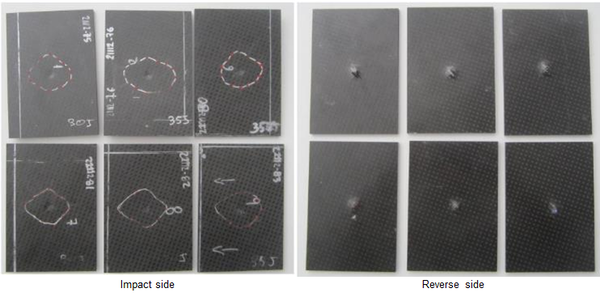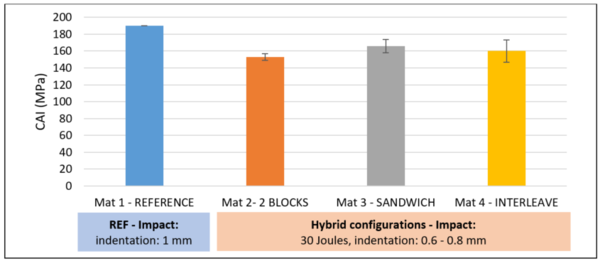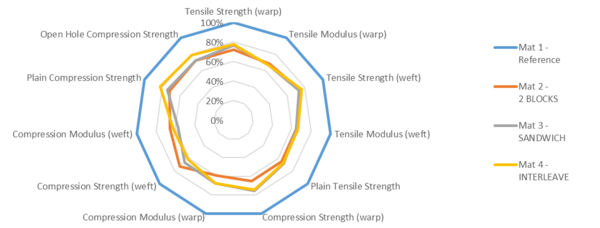ABSTRACT
English:
Our latest generation aircraft are more efficient by design, lighter and emit on average 25% less CO2 than previous generation aircrafts. Lightweight materials like composites have contributed significantly to reach the current emissions levels, like the A350 with more than 50% of structural weight made of composites.
However, composites drive also the environmental footprint of the aircraft life-cycle without considering the operational phase, involving currently important drawbacks in terms of energy consumption and waste recycling. The transition towards a composite circular economy needs to be anticipated due to the aviation sector de-carbonization challenge as well as the regulation evolution. This transition will be leveraged by several elements, being the composite recycling one of the most important, due to the need to transform the composite waste from production and end of life into new added value materials. For this, the development of efficient composite recycling technologies to not only recover energy during incineration but also high value recycled carbon fibers and semi-products are needed.
This work was focused on the recycling of dry carbon fiber scrap, which can proceed from part production by infusion technologies (e.g. RTM) or from pyrolysis of end of life composite part. The approach was to obtain a non-woven mat from the dry fiber scrap, following a mechanical process, which was, then, fully characterized to identify potential applications in aeronautical field. Different approaches of hybridization of the recycled non-woven mat with virgin carbon fiber fabric were also evaluated.
Español:
Nuestros aviones de última generación son más eficientes por diseño, más ligeros y emiten de media 25% menos CO2 que los aviones de la generación previa. Los materiales ligeros como los materiales compuestos han contribuido significativamente a alcanzar los niveles de emisiones actuales, como el A350 con más del 50% de su peso estructural fabricado en composites.
Sin embargo, los composites también influyen en la huella medioambiental del ciclo de vida de los aviones sin considerar la fase de operación, lo que actualmente implica importantes desventajas en términos de consumo de energía y reciclado de los desechos. Es necesario anticipar la transición hacia una economía circular de los materiales compuestos debido al desafío de la des-carbonización del sector, así como a la evolución de la regulación. Esta transición se verá influenciada por varios elementos, siendo el reciclado de los composites uno de los más importantes, debido a la necesidad de transformar los desperdicios generados en producción o al final de vida en nuevos materiales de valor añadido. Para esto, se necesita desarrollar tecnologías de reciclado de composite eficientes para recuperar no solamente energía durante la incineración sino también fibras de carbono y semi-productos reciclados de alto valor.
Este trabajo se ha centrado en el reciclado de desechos de fibra de carbono seca, que pueden proceder de la producción de piezas por tecnologías de infusión (ej. RTM) o de la pirólisis de pieza de material compuesto al final de su vida. El enfoque fue obtener un material no tejido a partir de los restos de fibra seca, mediante un proceso mecánico, que fue posteriormente caracterizado completamente para identificar posibles aplicaciones en el campo aeronáutico. También se evaluaron diferentes aproximaciones de hibridación del material no tejido con tejido de fibra de carbono virgen.
1. Introduction and scope
Composite parts production techniques based on dry carbon fiber textiles and liquid resin, e.g. RTM (resin transfer molding) or LRI (liquid resin infusion), have been considered traditionally as prone to produce high scrap quantity, due to the use of wide material rolls instead of ATL (automatic tape laying) rolls or AFP (automated fiber placement) spools. However, the generated material scrap during production is also easier to recycle, since there is not or very low resin content, which can simplify the recycling by just needing a suitable textile or dry fiber material production process that can be fed with this scrap type. Thus, there are already commercial alternatives, such as recycled carbon fiber non-woven materials.
The main motivation of this work was to evaluate a commercially available solution, non-woven mats, to recycle aeronautical dry carbon fiber scrap for aeronautical or non-aeronautical applications. These materials have a random short fiber orientation leading to final composites with poor fiber volume content and, then, low performance versus the state of art continuous and oriented carbon fiber aeronautical composites.
Then, the focus of this activity was the production, study and evaluation of a recycled non-woven mat from dry carbon fiber fabric scrap, which is generated during the RTM production of aeronautical composite parts. The production of this non-woven mat was performed by an external company, STFI. Then, RTM process with standard aeronautical liquid resin was used to obtain composites with a carbon fiber volume content, and then mechanical properties, as high as possible. The produced flat composite panels were, then, characterized from mechanical point of view. Additionally, in order to reach higher mechanical performance, above all in terms of impact resistance, hybrid composite panels combining the recycled non-woven mat and a standard dry carbon fiber fabric were produced and characterized.
2. Recycled carbon fiber non-woven mat production
State of Art recycled carbon materials can be obtained from dry carbon fiber material scrap or recovered carbon fibers from composites after resin removal processes (e.g. pyrolysis, solvolysis…) [1]. Among these options, the solution selected was the production of a short carbon fiber non-woven mat [2] by an external partner, STFI (Saxon Textile Research Institute e.V., Germany) [3], which is a research institute with the capabilities to produce carbon fiber non-woven mat following the requirements of this activity.
The scrap source to produce the non-woven mat were expired virgin rolls of reference carbon fiber fabric (5HS), with epoxy binder and 370 gsm nominal areal weight, used in the RTM production of aeronautical composite parts. Production carbon fabric wastes were not used in this work, since this would impact in the schedule, due to the time needed to generate and compile the material scrap.
A standard mechanical process to produce non-woven mats was used, which includes following steps: cutting or shredding to homogenize the feeding material, carding to align the carbon fiber and get a thin mat, cross-lapping where the roll overlaps until the needed fiber weight is achieved, and, finally, needle punching to compact the plies and get the final carbon fiber non-woven mats. It is important to highlight that, taking into account the non-woven mat production process, as it can be seen in Figure 1, the final material has some short carbon fiber orientation, which is almost transversal to the material roll production direction.
The target carbon fiber non-woven mat areal weight was very low, 100 gsm, in order to get better final composite fiber volume content and mechanical properties, with a 50” (1270 mm) roll width. Although the first non-woven mat production trials with 100 gsm areal weight did not provide good results, since the obtained mats were easily broken, after a fine setup of the STFI production process and equipment, acceptable low areal weight non-woven mat rolls were obtained: 50 to 90 gsm, 70 to 100 gsm, 100 to 130 gsm, as it can be seen in Figure 1.
3. Composite panels production
3.1. Recycled carbon fiber non-woven mat
Resin Transfer Molding (RTM) was the selected process to produce flat panels with the non-woven mat and standard liquid RTM resin. While the non-woven mats from expired dry carbon fabric rolls were being produced, the first RTM panel manufacturing trials were performed using an available carbon fiber non-woven mat with 300 gsm theoretical areal weight, manufactured also by STFI, to set up a starting point for RTM manufacturing process with this material type. Panels were produced by using a 500 mm x 500 mm mold, with an 8.7 mm cavity.
For the first panel, up to 15 plies of the 300 gsm non-woven mat were introduced in the mold, leading to a theoretical fiber volume content (FVC) of 28-29 %, since 16 plies did not allow a correct vacuum tightness of the mold. This first panel showed strong thickness deviations, going up to 9.7 mm in the center and 9.2 mm in the edges, versus the theoretical value of 8.7 mm. These deviations could be generated by an excess of non-woven mat plies, so for the next panel production trial the number of plies was reduced to 13, resulting in a theoretical FVC of 24.4 - 25.3 %. In this case the measured panel thickness was closer to the theoretical value, around 9 mm in the panel center.
These two panels were analyzed by non-destructive inspection (NDI) using standard ultrasounds, although there was not NDI reference available for this material type. High ultrasonic attenuation differences were found in different panel areas. However, taking into account the nature of the material being evaluated, short carbon fiber material with low homogeneity and orientation, this NDI result is not fully indicative of potential defects in the panel. That is why the panels were also evaluated by microscopy. Micrographs obtained show good internal quality, as there is low porosity, like in case of samples shown in Figure 2.
Moreover, fiber, resin and void contents were measured by means of acid digestion (according to EN2564 [4]), see results in Table 1. These tests also show good and similar results for both evaluated panel samples, without voids, although the testing method error needs to be taken into account. This proves that RTM process is a good option for the manufacturing of composite parts with this kind of recycled carbon fiber non-woven material.

a) |

b) |
| Panel | Wr (%) | Wf (%) | Vr (%) | Vf (%) | Vo (%) |
| Panel 15 plies – Sample 1 | Avg.: 67.9
Std.: 0.7 |
Avg.: 32.1
Std.: 0.7 |
Avg.: 77.3
Std.: 0.6 |
Avg.: 23.6
Std.: 0.7 |
Avg.: -0.9
Std.: 0.2 |
| Panel 13 plies – Sample 1 | Avg.: 68.1
Std.:1.1 |
Avg.: 31.9
Std.: 1.1 |
Avg.: 77.0
Std.: 1.0 |
Avg.: 23.3
Std.: 0.8 |
Avg.: -0.2
Std.: 0.2 |
After these preliminary trials to set up the production process, panels were produced with the recycled non-woven mat from expired virgin dry carbon fabric rolls. Among the 3 available carbon fiber non-woven mats with different areal weights, the heaviest one was selected (100 – 130 gsm areal weight), due to lower areal weight tolerance, in order to reduce the panel thickness deviations, as well as higher material consistency. In any case, the cutting process of this material was still more difficult than in case of standard aeronautical carbon fiber textiles.
Panels were manufactured and tested following the predominant fiber orientation, then, the non-woven roll production direction is considered the short carbon fiber 90 degrees direction. For the first panel produced with this recycled carbon fiber non-woven mat, some thickness deviations were obtained between the panel center and edges, as in case of previous non-woven mat panels. The panel calculated FVC was around 28 %.
Four panels were produced with different lay-ups (unidirectional, quasi-isotropic - QI) and theoretical thickness (2mm, 4mm) for the characterization campaign. As it can be seen in Figure 3, these panels showed surface marks, which were generated by the mold surface.
3.2. Hybrid configurations
With the aim to increase the composite material mechanical properties, a new approach based on the hybridization between recycled carbon fiber non-woven mat and virgin carbon fiber 5HS fabric was implemented. Three different hybridization approaches were considered by mixing plies of recycled non-woven mat (100- 130 gsm) with of plies of virgin carbon 5HS fabric (370 gsm), considering in this first step only 1/3 of total plies of recycled carbon fiber non-woven mat and 2/3 of total plies of virgin carbon fiber fabric, to obtain 2 and 4 mm theoretical thickness panels for the characterization campaign, as included in Table 2. Taking into account the areal weight of the mixed materials, only 14% of the total hybrid carbon lay-up areal weight comes from the recycled material, in order to minimize the effect in the final composite mechanical properties.
The panels with 2 blocks configuration ended up being slightly curved due to the lack of lay-up symmetry, which could be expected. Sandwich and interleaf configuration panels did not show any visible effects.
| Configuration | Lay up
2 mm thick panels |
Lay-up
4 mm thick panels |
| 2 Blocks | [(0/90)]4 / [0]2 | (+45/-45) / (-45/+45) / (0/90) / (90/0) / (90/0) / (0/90) / (-45/+45) / (+45/-45) / 0 / 90 / 90 / 0 |
| Sandwich | [(0/90) / (0/90) / 0]s | [(+45/-45) / (-45/+45) / (0/90) / (90/0) / 0 / 90]s |
| Interleave | [(0/90) / 0 / (0/90)]s | [(+45/-45) / (-45/+45) / 0 / (90/0) / (0/90) / 90 ]s |
| Recycled carbon fiber non-woven material, virgin carbon fiber 5HS fabric (1 ply – 2 directions) | ||
4. Composite panels characterization
4.1. Recycled carbon fiber non-woven mat
A test plan was defined in order to characterize the composite panels produced by RTM with recycled carbon fiber non-woven material and reference liquid resin, including tensile strength and modulus with UD lay-up – coupon longitudinal direction aligned with / normal to the non-woven mat roll production direction (test method: ISO 527-4 [5] type 3), plain tensile strength with QI lay-up (test method: AITM 1-0007 [6] type A), compression strength with UD lay-up – coupon longitudinal direction aligned with / normal to non-woven mat roll production direction (test method: EN 2850 [7] type A), plain and open hole compression (OHC) with QI lay-up (test method: AITM 1-0008 [8] type A and B) and, finally, compression after impact with QI laminate (test method: AITM 1-0010 [9]).
Results obtained were compared with average requirement values for standard modulus carbon fiber fabric (with or without binder) 5H Satin, 370 gsm and liquid epoxy resin 180 ºC curing (AIMS 05-04-009 [10]). Mechanical test results (average values) versus the reference material requirements are represented in Figure 4. At this point, it is important to highlight that we are comparing a short carbon fiber non-woven material with a continuous carbon fiber fabric material, then, an important drop of properties was expected.
Additionally, impact tests were carried out, which showed that the composite material produced with recycled carbon fiber non-woven material and standard RTM epoxy resin is too brittle. Then, the specimens were not able to withstand very low energy impact levels of 10 Joules, producing local surface damages or cracks in the specimen backside, while as the energy increased up to 50 Joules a catastrophic specimen failure occurred, as it can be observed in Figure 5. This poor impact resistance behavior is not acceptable for aeronautical applications, then, it was decided not to proceed with the compression after impact (CAI) test.
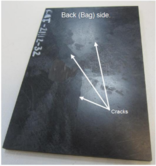
a) |
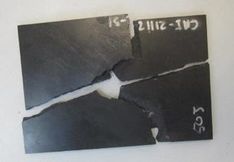
b) |
4.2. Hybrid configurations
The three flat panels produced with different hybrid configurations (2 blocks, sandwich and interleave) were characterized following the same testing program as in case laminates made of pure recycled carbon fiber non-woven mat. However, due to the unacceptable impact resistance results obtained with this non-woven material, the characterization campaign of the hybrid laminates was started by the impact tests, to evaluate if these hybrid configurations could overcome this issue.
Since the three hybrid configurations showed better impact resistance behavior, obtaining an impact damage depth of 0.6 - 0.8 mm in case of 30 Joules impact, and a good progression and correlation between impact energy and damage size, in line with reference continuous carbon fiber 5HS fabric RTM composite impact behavior (impact energy: 30 Joules, indentation: 0.54 mm), it was decided to carry out the compression after impact tests. Impacted specimens with sandwich hybrid configuration as example are included (Figure 6) and the results of CAI test (AITM 1-0010 [9]) obtained for the different hybrid configurations versus the average requirement for the reference carbon fiber 5HS fabric 370 gsm / liquid epoxy resin 180 ºC curing (AIMS 05-04-009 [10]) are compiled in Figure 7.
The rest of the hybrid configuration laminate mechanical test results (average values) are shown versus the reference material requirements in the graph represented in Figure 8.
5. Conclusions and next steps
Regarding the recycled carbon fiber non-woven mat, the following conclusions were obtained:
- Recycled carbon fiber non-woven materials with low areal weight (100-130 gsm) and good consistency have been produced by STFI from conventional expired RTM carbon fiber fabric (5HS) with epoxy binder (370 gsm areal weight).
- Composite panels with recycled carbon fiber non-woven mat and standard liquid epoxy resin 180 ºC curing class with good quality have been manufactured by RTM, although specific NDI needs to be developed, since ultrasonic inspection in terms of traditional quality control of CFRP is not applicable for this type of material. Fiber volume contents of 23-24 % were obtained, versus initial and typical lower values for this material type.
- Mechanical characterization results of composites vs. requirements for continuous carbon fiber 5HS fabric 370 gsm / liquid epoxy 180 ºC curing (AIMS 05-04-009 [10]): tensile strength of 19-27 %, tensile modulus of 22-36 %, compression strength of 38-54 %, compression modulus of 20-31 % and OHC strength of 63 %.
- Impact tests performed show that the composite material produced with recycled non-woven mat is too brittle, being a showstopper for the aeronautical application of this recycled material solution.
With regards to the hybrid configuration composite panels, combining recycled carbon fiber non-woven mat (100 - 130 gsm) and virgin carbon 5HS fabric (370 gsm) – 2 blocks, sandwich and interleave configurations, with only 14 % of the total hybrid carbon lay-up areal weight coming from the recycled non-woven mat, which means a reduction of the carbon lay-up areal weight of 8% vs. using only virgin reference carbon 5HS fabric layers:
- Flat composite panel production by RTM showed no issues and good quality.
- Composite impact resistance behavior close to reference continuous carbon fiber 5HS fabric. CAI (impact energy: 30 Joules, indentation: 0.6-0.8 mm) of 81-87 % vs. requirement for continuous carbon fiber 5HS fabric 370 gsm / liquid epoxy 180 ºC curing (indentation: 1 mm, AIMS 05-04-009 [10]).
- Mechanical characterization results of RTM composites vs. requirements for continuous carbon fiber 5HS fabric 370 gsm / liquid epoxy 180 ºC curing (AIMS 05-04-009 [10]): tensile strength of 65-78 %, tensile modulus of 65-68 %, compression strength of 61-82 %, compression modulus of 59-67 % and OHC strength of 72-79 %.
Then, regarding the next steps for the recycled carbon fiber non-woven material and hybrid configurations, new more balanced hybridization approaches will be considered in terms of weight % of recycled mat and reference virgin continuous carbon / glass fiber fabric, e.g. internal thick block of recycled non-woven mat with external surface virgin fabric layers, with the aim of minimizing the virgin fabric material content while obtaining acceptable properties for aeronautical loaded, low / non-loaded and/or functional applications, e.g. solid shim / fillers, brackets, clips, fairings, cabin panels …, and/or non-aeronautical applications, e.g. automotive…
Finally, the production and evaluation of a recycled fabric obtained from dry carbon fiber production scrap will be also investigated, as a suitable option to obtain better mechanical properties, following the same development path, including recycled carbon fiber yarn and fabric development and production in collaboration with a textile company, RTM composite panels manufacturing and characterization campaign. The hybridization of this recycled fabric with the recycled non-woven mat can also be considered to maximize the content of recycled carbon fiber content in final applications.
6. Acknowledgement
The work included in this article has been done inside the OPTIMUS project, which has been funded by the Spanish funding body CDTI (‘Centro para el Desarrollo Tecnológico Industrial’) with grant number MIG-20211010 through the 2021 call for granting funds for Science and Innovation Missions (‘Misiones’), within the Recovery, Resilience and Transformation Plan (funded by the Next Generation EU funds – Recovery and Resilience Mechanism) and the State Program to catalyze the Innovation and Business Leadership of the State Plan for Scientific and Technical Research and Innovation 2021-2023.
7. References
| [1] | V. S. C. H. W. Jin Zhang, «Current status of carbon fibre and carbon fibre composites recycling,» Science Direct, 15 July 2020. |
| [2] | S. Pickering, «Nothingam University,» [En línea]. Available: https://www.nottingham.ac.uk/research/groups/composites-research-group/research/recycling-of-composites/recycling-of-carbon-fibre-composites-by-solvolysis-at-atmospheric-pressure.aspx. [Último acceso: 10 05 2023]. |
| [3] | STFI, «STFI,» [En línea]. Available: https://www.stfi.de/en/. [Último acceso: 22 05 2023]. |
| [4] | EN 2564. Aerospace series - Carbon fibre laminates - Determination of the fibre, resin and void contents. |
| [5] | ISO 527-4 Tensile Properties of Isotropic and Orthotropic Fiber-Reinforced Plastic Composites. |
| [6] | AITM 1-0007. Airbus Test Method - Determination of Plain, Open Hole and Filled Hole Tensile Strength. |
| [7] | EN 2850 - Aerospace series - Carbon fibre thermosetting resin - Unidirectional laminates - Compression test parallel to fibre direction. |
| [8] | AITM 1-0008. Airbus Test Method - Determination of Plain, Open Hole and Filled Hole Compression Strength. |
| [9] | AITM 1-0010. Airbus Test Method - Determination of Compression Strength After Impact. |
| [10] | AIMS 05-04-009 - Airbus Material Specification - Standard Modulus Carbon Fibre Fabric (with or without Binder) 5H Satin, 370 g/m2 - Liquid Epoxy Resin 180ºC Curing. |
Document information
Published on 12/04/24
Accepted on 04/12/23
Submitted on 24/05/23
Volume 08 - COMUNICACIONES MATCOMP21 (2022) Y MATCOMP23 (2023), Issue Núm. 4 - Sostenibilidad y Reciclaje, 2024
DOI: 10.23967/r.matcomp.2024.04.05
Licence: Other
Share this document
Keywords
claim authorship
Are you one of the authors of this document?

